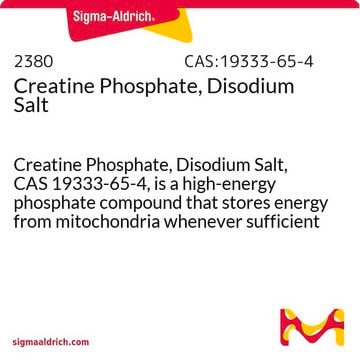C7886
Creatine Phosphokinase from bovine heart
Type III, salt-free, lyophilized powder, ≥30 units/mg protein
Synonym(s):
ATP: Creatine N-Phosphotransferase, CPK, Creatine Kinase, Phosphocreatine phosphokinase
Sign Into View Organizational & Contract Pricing
All Photos(2)
About This Item
Recommended Products
biological source
bovine heart
description
Contains primarily isozyme MM
type
Type III
form
salt-free, lyophilized powder
specific activity
≥30 units/mg protein
mol wt
80 kDa
storage temp.
−20°C
General description
Research area: Cell Signaling
Creatine phosphokinase (CPK) is an intracellular enzyme found predominantly in skeletal muscle, brain, and myocardium. CPK consists of two polypeptide subunits, namely M (muscle type) and B (brain type). The lighter subunit is present in larger amounts. The genes encoding these subunits are on distinct chromosomes, with B on 14q32 and M on 19q13. These subunits facilitate the development of three tissue-specific isoenzymes: CPK-MB (cardiac muscle), CPK-MM (skeletal muscle), and CPK-BB (brain).
Creatine phosphokinase (CPK) is an intracellular enzyme found predominantly in skeletal muscle, brain, and myocardium. CPK consists of two polypeptide subunits, namely M (muscle type) and B (brain type). The lighter subunit is present in larger amounts. The genes encoding these subunits are on distinct chromosomes, with B on 14q32 and M on 19q13. These subunits facilitate the development of three tissue-specific isoenzymes: CPK-MB (cardiac muscle), CPK-MM (skeletal muscle), and CPK-BB (brain).
Application
Creatine Phosphokinase from bovine heart has been used:
- in the reaction mix for the import of in vitro synthesized wild-type FLAG/MYC-tagged LYR Motif Containing 7 (LYRM7-F/M) or the LFK tripeptide replaced with alanine (LFK-AAA) mutant into isolated mitochondria
- in autoubiquitination assay
- in the preparation of premix buffer for adenylyl cyclase activity
- in the preparation of E-mix for in vitro nuclear assembly and isolation
- in in vitro vesicular fusion assay.
- in ATP regeneration system, to facilitate the reactivation of nonmotile axonemes.
- in subcellular in vitro fusion assay of autophagosome with lysosome.
- in in vitro protein translation assay.
- for tATPase assay of myofibrillar protein isolated from rabbit. This assay evaluated the kinetic influence of bound creatine kinase (CK) on Ca2+-activated myosin ATPase.
- for the enzymatic hydrolysis of protein samples during tryptophan estimation by pyrolysis gas chromatography.
Creatine phosphokinase from bovine heart has been used to investigate whether endothelial cell growth is stimulated by ischemic hearts. Creatine phosphokinase from bovine heart has also been used to evaluate the effect of high but nontoxic dietary intake of copper and selenium on metabolism in calves.
Biochem/physiol Actions
Creatine kinase plays a key role in the energy metabolism of cells with intermittently high and fluctuating energy requirements. Examples of such cells include cardiac or skeletal muscle cells and neural tissues of brain and retina. The enzyme catalyzes the reversible transfer of the phosphoryl group from phosphorylcreatine to ADP, in order to generate ATP. The molecular mass of the protein is found to be approximately 80,000 Da. It is made up of 2 subunits, each having a molecular weight of 40,000 ± 2000. The lighter subunit is present in larger amounts.CPK is released from the cellular cytosol into the systemic circulation due to disruption of cell membranes caused by hypoxia or other injuries. Furthermore, it serves as a diagnostic indicator for rhabdomyolysis and acute myocardial infarction (AMI), along with other medical disorders such as acute muscle injury, arrhythmias, and congestive cardiac failure.
Caution
The use of 0.1% albumin in the reaction buffer is recommended to avoid inactivation due to dilution.
Unit Definition
One unit will transfer 1.0 μmole of phosphate from phosphocreatine to ADP per min at pH 7.4 at 30 °C.
Analysis Note
Protein determined by biuret.
Storage Class Code
11 - Combustible Solids
WGK
WGK 3
Flash Point(F)
Not applicable
Flash Point(C)
Not applicable
Personal Protective Equipment
dust mask type N95 (US), Eyeshields, Gloves
Certificates of Analysis (COA)
Search for Certificates of Analysis (COA) by entering the products Lot/Batch Number. Lot and Batch Numbers can be found on a product’s label following the words ‘Lot’ or ‘Batch’.
Already Own This Product?
Find documentation for the products that you have recently purchased in the Document Library.
Customers Also Viewed
Cholesterol impairs autophagy-mediated clearance of amyloid beta while promoting its secretion
Barbero-Camps E, et al.
Autophagy, 14(7), 1129?1154-1129?1154 (2018)
Internal friction controls active ciliary oscillations near the instability threshold
Mondal D, et al.
Science Advances, 6(33), eabb0503-eabb0503 (2020)
P J Russell et al.
Clinical chemistry, 30(9), 1555-1557 (1984-09-01)
Elemental sulfur is a specific and potent inhibitor of the muscle-type isoenzyme of adenylate kinase (EC 2.7.4.3). We find inhibition by sulfur and by diadenosine pentaphosphate to be similarly potent and specific. Some properties of inhibition of adenylate kinase isoenzymes
Mucoricin is a Ricin-Like Toxin that is Critical for the Pathogenesis of Mucormycosis
Soliman SSM, et al.
Nature microbiology, 6(3), 313?326-313?326 (2021)
A general strategy for discovery of inhibitors and activators of RING and U-box E3 ligases with ubiquitin variants
Gabrielsen M, et al.
Molecular Cell, 68(2), 456-470 (2017)
Our team of scientists has experience in all areas of research including Life Science, Material Science, Chemical Synthesis, Chromatography, Analytical and many others.
Contact Technical Service













